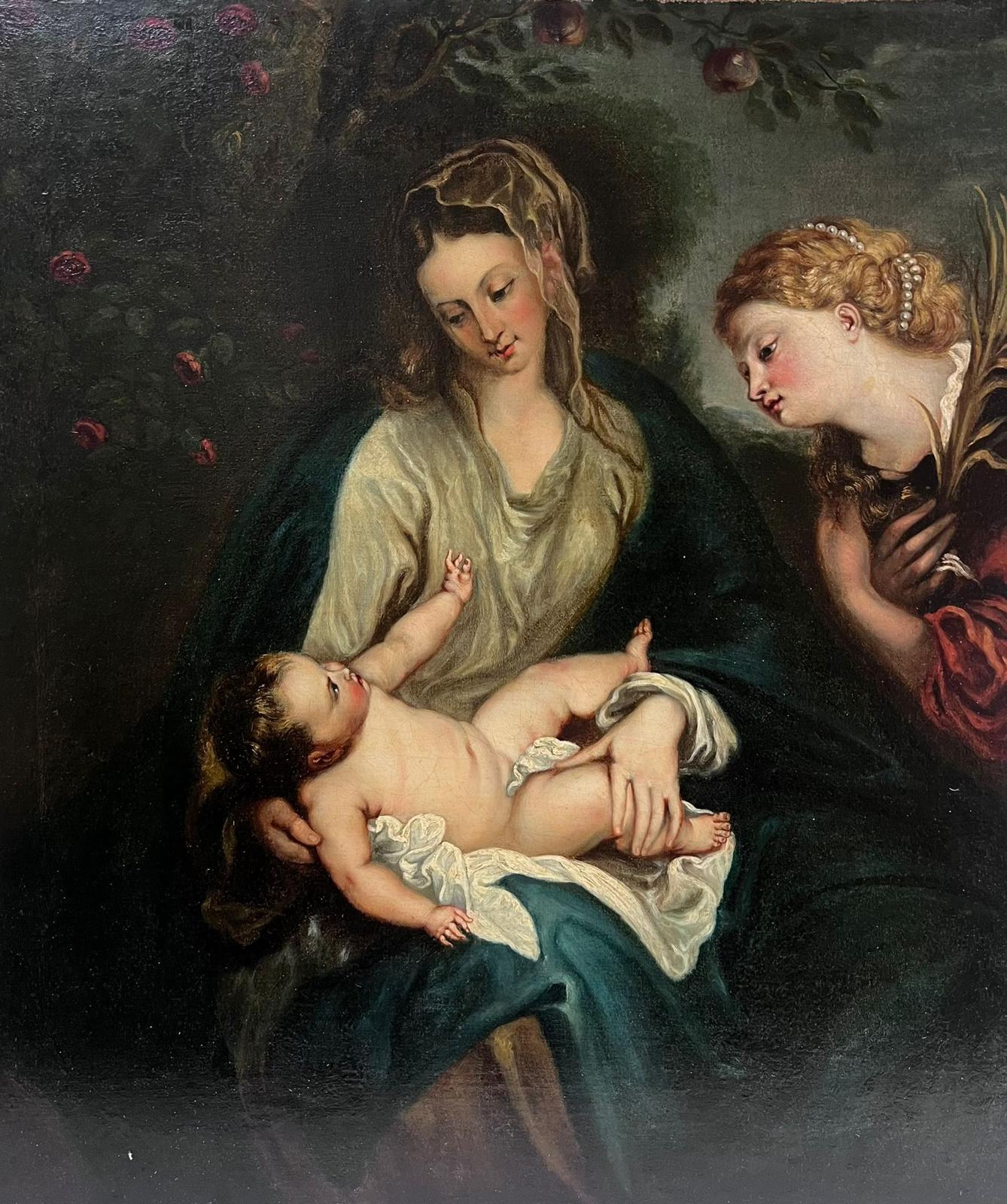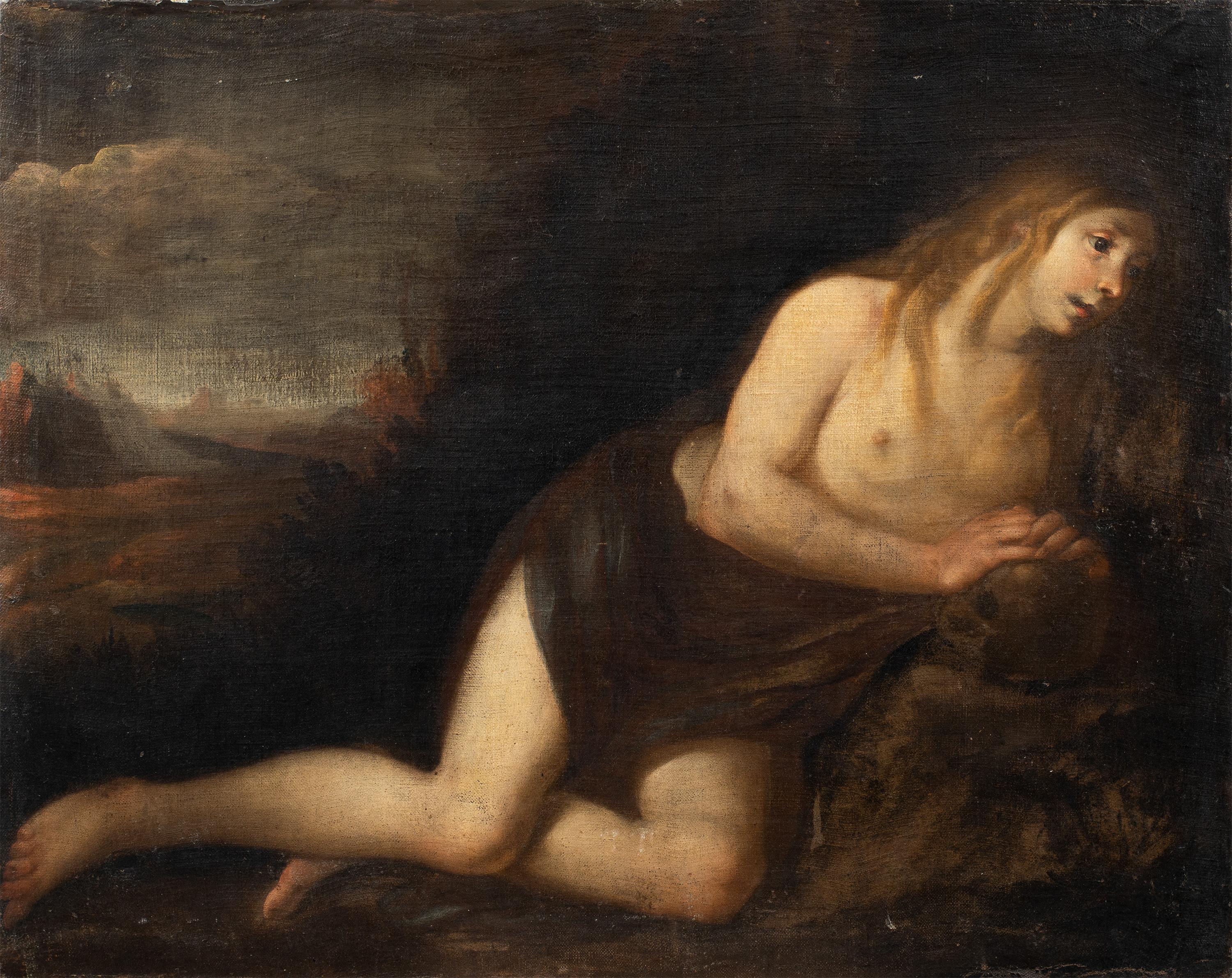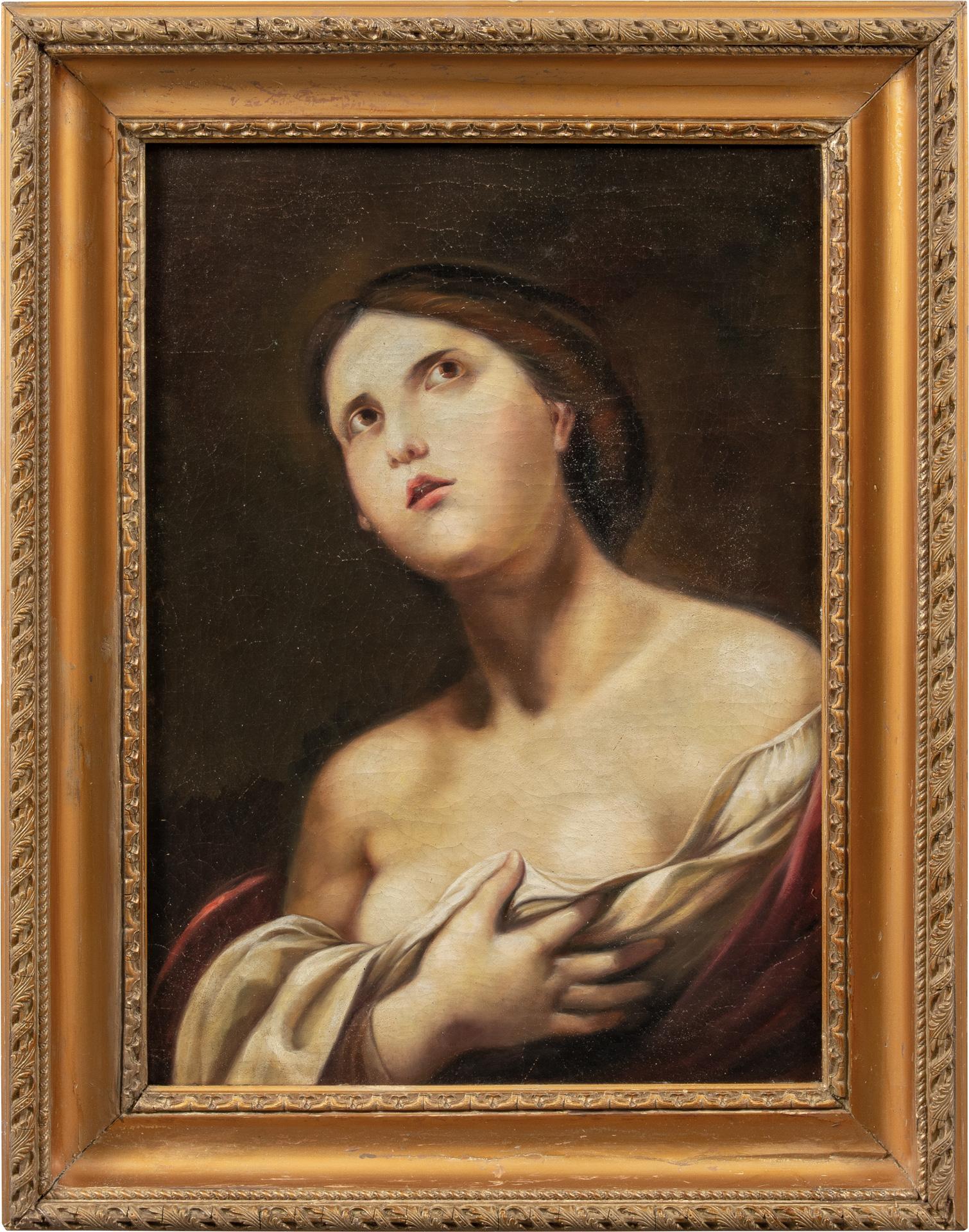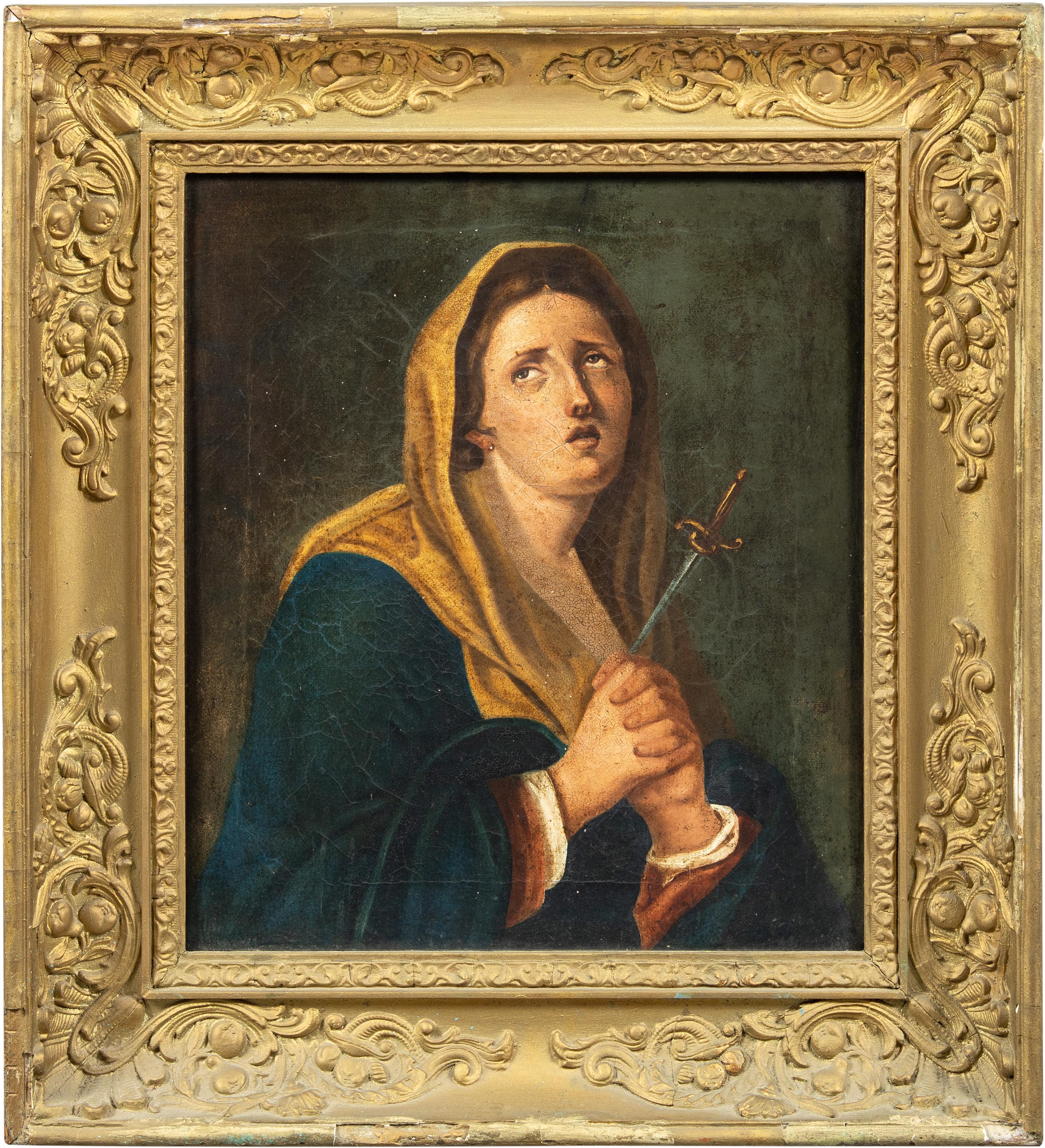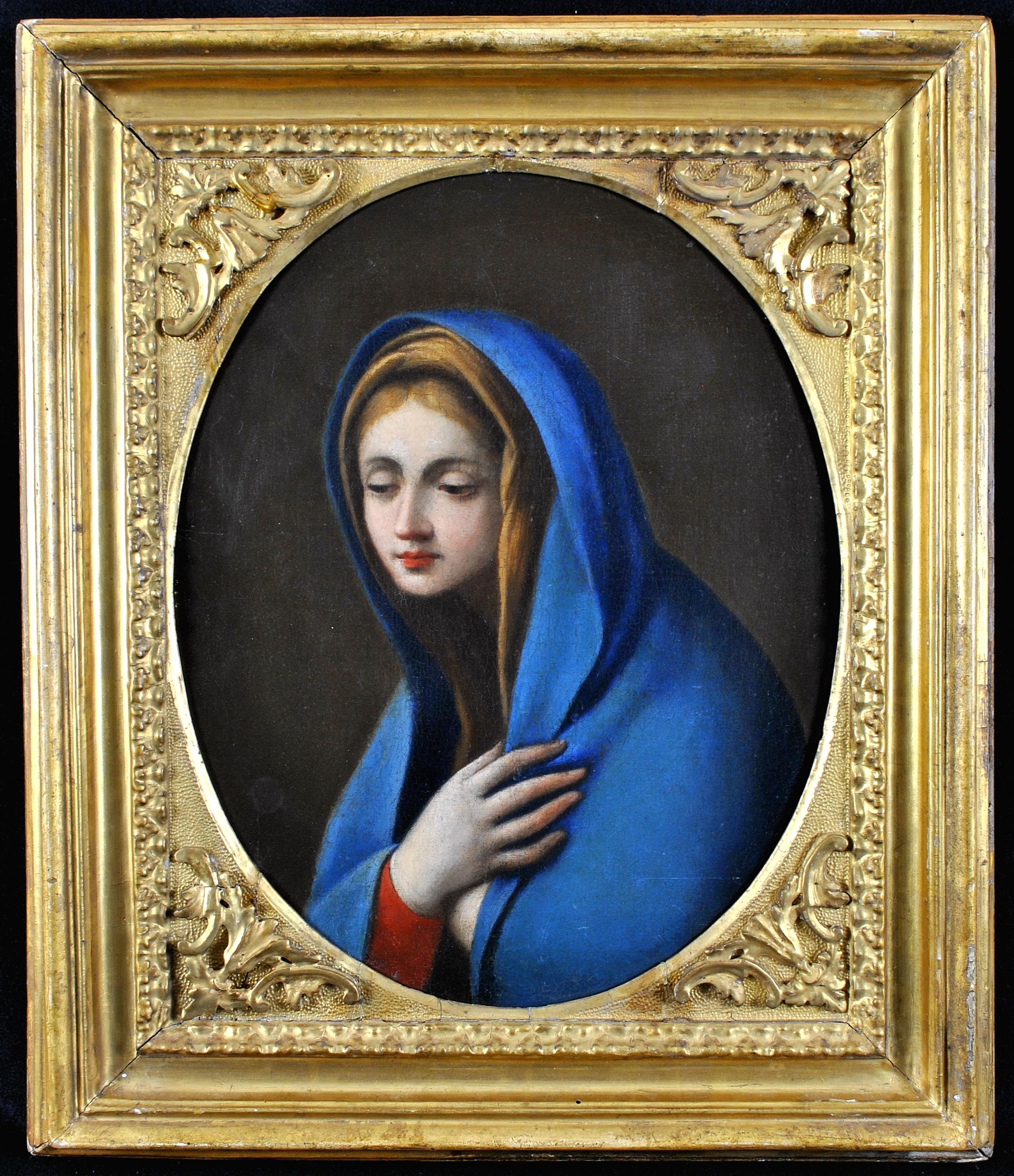Items Similar to Two Sisters
Want more images or videos?
Request additional images or videos from the seller
1 of 4
Two Sisterscirca 1655
circa 1655
About the Item
oil on canvas
46.7 x 37.2 inches (118.5 x 94.5 cm.)
PROVENANCE
Private Collection, Isle of Wight
Two young sisters are posed on a portico backed by a rotund column with a landscape beyond. Although their identities are unknown their outfits as well as the setting denotes wealth and status. The older sister wears a gown of gold with blue and gold trim raised to reveal a green underskirt also edged with gold. Her collar tied at the neck and fastened over her shoulders by a large rosette of golden cloth, apron and cuffs over wide sleeves, are all of a sheer batiste linen trimmed with lace. Previously a child would not have been painted in a bib or apron above the age of three, but in the 1650s and 1660s it became fashionable for older girls. A leading string hangs from her right shoulder, which is also surprising given her age, but once their utility was gone, they were viewed as a decorative accessory and remained part of children’s costumes. She wears double strands of coral around her wrists, as does her little sister whose are triple layered who also has a coral necklace. Coral was believed to ward off disease and evil spirits, and just as coral once removed from reefs could be transformed into precious stones hopefully so too did a child develop. Her cap is linen and lace with gold bows in her hair, and two loose curls framing her face. Roses grow behind her, the symbol for love, and in her left hand she presents a carnation to her sister emblematic of betrothal. Although a rare feature in children’s portraiture, as it was usually reserved for couples and family groups, there is at least one other example known of children represented with this flower.
The seated younger sister wears a sheer linen bib and apron over a light grey dress with linen cuffs. Her flat shoulder collar is linen trimmed with lace similar to her cap. Her stockings and shoes are gold. Her hair is arranged identically to her older sister. While the older sister holds down her apron, the younger’s has been blown sideways and her hem lifted as is the right edge of her collar. In this capacity the wind can be viewed as capable of driving out evil and attracting goodness. In her arms the little girl holds a doll, suggestive of her future role of motherhood. Most dolls were made of wood and produced in Germany. Typically they represent grown women, fashionably dressed, often with movable limbs. Many times the doll’s clothing echoes that of the sitter. Brightly dressed, the doll’s bib and collar resemble that of the little sister, while the black cap with gold trim differ.
Just behind the girls is a massive column consisting of several round blocks, which can be viewed as symbolic of fortitude and constancy. This type of column resembles those in the portico of Ruben’s courtyard and were reproduced in a number of Flemish seventeenth century paintings.
The vogue for painting children with architectural elements or in pastoral landscapes became popular in the Southern Netherlands about mid-century. In this work both trends are combined. The placement of the girls on a terrace at sunset suggests ownership by the family of a country estate. Life in the country was perceived as peaceful, contemplative and free of worry or hardships. If property was unaffordable, the assumption of ownership could be attained on canvas. By painting the light in this work to reflect sunset, the suggestion of tranquility and the association with antiquity were heightened. The inclusion of a reference to antiquity stems from the popularity of pastoral literature at this time which presented a vision of Arcadia as a paradise free of the mundane tribulations of daily life, particularly those encountered in town and court.
Fascinatingly the period of this painting’s execution coincides with an economic recession in Flanders which appears to have resulted in an overall decline in the painting of children’s portraits. The Two Sisters are the embodiment of the hopes, dreams and aspirations all families cherish for their children. By having their images recorded for posterity, perhaps during a period of economic constraint for the family, the contemporary viewer has been given a gift and an invaluable insight into the period.
We would like to thank Katlijne Van der Stighelen for identifying this work as Flemish circa 1650 – 1660, and her incalculable contribution to the writing of this fact sheet.
- Attributed to:Flemish School, 17th Century (1600 - 1699)
- Creation Year:circa 1655
- Dimensions:Height: 46.66 in (118.5 cm)Width: 37.21 in (94.5 cm)
- Medium:
- Movement & Style:
- Period:
- Condition:Please contact us for a Condition Report on this painting.
- Gallery Location:New York, NY
- Reference Number:1stDibs: LU2558212462752
About the Seller
No Reviews Yet
Vetted Seller
These experienced sellers undergo a comprehensive evaluation by our team of in-house experts.
Established in 1989
1stDibs seller since 2023
- ShippingRetrieving quote...Ships From: New York, NY
- Return PolicyThis item cannot be returned.
More From This SellerView All
- Brotherly LoveLocated in New York, NYsigned in the lower right Kever watercolor on paper 19 3/16 x 17 1⁄8 inches (49.2 x 43.7 cm.) PROVENANCE Dr. Katherine Kromm Merritt, Stamford, Connecticut, until circa 1990, from whom acquired by Private Collection, Vinalhaven, Maine, until 2015 In the warm morning glow of a country kitchen, a young boy entertains his little sister seated in a high chair. In return her adoring glance speaks volumes. The dramatic angling of the baby’s high chair, whose design harks back to the seventeenth century, animates the scene. Through an economy of means and a limited palette of largely brown and orange, Jacob Simon Hendrik Kever captures the richness of the moment and its idyllic rusticity. Josef Israels was the first to encourage Kever to study painting. He began his training at the Koninklijke Academie voor Beeldende Kunsten, Amsterdam, in 1869, studying with Petrus Franciscus Greive until 1872. From 1874 - 1875 he attended the Rijksakademie van Beeldende Kunsten, also in Amsterdam. From 1878-1879 under the tutelage of Charles Verlat he was enrolled in the Koninklijke Acaemie voor Schone Kunsten in Antwerp. His subjects included portraits, cityscapes, landscapes, flowers, genre and interior scenes in watercolors, oils, and etchings. Throughout his career he worked in Blaricum, Nunspeet, the province of North Brabant and Eemnes. Although not technically considered a member of the Laren School he also lived there from 1877-1879 and again in 1905-1922. He further maintained an apartment in Amsterdam near the Oosterpark where he resided during the winter months. The area must have constituted somewhat of an artist’s community as his neighbors were Geo Poggenbeek, Nicolaas Bastert and later Willem Witsen...Category
Late 19th Century Dutch School Interior Paintings
MaterialsWatercolor
- A Boar Hound with a Joint of Meat Near an Enraged CatLocated in New York, NYsigned in the upper right Gio Batta Weenix oil on canvas 45 x 51 inches (114.5 x 129.5 cm.) PROVENANCE (possibly) Giovanni Baptista Weenix estate sale, Huis ter Mey, De Haar, Apr...Category
Mid-17th Century Old Masters Animal Paintings
MaterialsOil
- A View of Capodimonte and A View of Posillipo in Naples; Two DrawingsLocated in New York, NYPROVENANCE Mortimer Brandt, until 1993 and thus by descent in the family to Private Collection, Baltimore until the present time We would like to thank Charles Beddington for ident...Category
Late 17th Century Old Masters Landscape Drawings and Watercolors
MaterialsPen, Ink, Laid Paper
- At Grandmother’sLocated in New York, NYsigned in the lower left Artz oil on canvas 26 x 19 ⅝ inches (66 x 50 cm.) PROVENANCE D. Sala & Zonen, Leiden , prior to 1936 Private Collection, Florida, circa 1968 until the present time Much like their seventeenth century counterparts, a group of painters known as the Hague School in the 1870s came to embrace as their subject matter the native Dutch landscape and the everyday lives of its rural inhabitants, most notably the fisher folk of the coastal villages. Within ten years the Hague School artists’ works would prove so popular that incredibly a mania for all things Dutch would be felt throughout the world, and would dominate the art in Holland until well after the turn of the century. By embracing simple themes remarkable for their ordinariness, the Hague School succeeded in striking a chord with a public whose own placidity was constantly being rattled by the evolving modernity of the times. Conveyed through the employment of subtle tones, hazy skies and subjects of happenstance their mix of nostalgia and realism enchanted viewers. The Hague became the center of the movement because it was semi-rural surrounded by meadows, polders, waterways, dunes and woods, and nearby Scheveningen provided a wealth of material for artists seeking to paint the shore and its fishing community. Jozef Isräels was considered the dean of the Hague School and David Adolphe Constant Artz his most important follower. Artz began his training in 1855 at the Amsterdam Academie under Louis Roijer and Johannes Egenberger, and would remain in Amsterdam until 1864. During this period, he would be influenced by August Allebé but more importantly a lifelong friendship with Jozef Israëls formed. In 1859 they traveled together to Zandvoort. He would also be the first of the Hague School artists to follow Isräels’ lead of working on the beach at Scheveningen. In 1859 Artz publically exhibited for the first time, taking part in the Tentoonstelling von Levende Meesters (Exhibition of Living Masters). In 1864 he left Amsterdam to live in Zweeloo, Drenthe for a year. From 1866 until 1874 he shared a studio with Jacob Maris and Frederick Hendrik Kaemmerer. He was one of the first of the Hague School artists to work in Paris (Jacob Maris having preceded him by one year) enabled by his patron and benefactor Johannes Kneppelhout. Artz created quite a commotion upon his arrival by including in his baggage a large collection of Scheveningen peasant costumes. As previously in Holland, Artz during his sojourn in Paris continued to paint beach scenes and interior views that featured the fishing communities of the North Sea. During this period Artz became interested in Japanese prints which had recently become available in Paris, and painted a few genre scenes of interiors with Japanese décor and subjects. While based in Paris he also traveled to Scotland from May-June 1869, Germany in November of that year, England in 1870 and Italy in January, 1872. By 1874 he returned to the Netherlands to live permanently in The Hague. Artz in his own time was held in high esteem by the public as well as his fellow artists. He was awarded gold medals at exhibitions in Munich and Vienna, as well as a Diploma and Medal of Honor in Dresden. In 1879 he was made Knight of the Oaken Crown of Luxembourg and in 1889 also became a Knight of the Order of St. Michael of Bavaria. In 1880 he received an Honorable Mention at the Salon in Paris and won a gold medal in 1883 at the International and Colonial Exhibition, Amsterdam. In Paris he was a member of the Société Nationale des Beaux Arts and a Chevalier of the Legion of Honor by 1889. He also served as Vice President of the International Jury of Award at the 1889 Exposition Universelle, Paris. In 1893 four works by Artz were chosen to be included in the World’s Columbian Exposition, Chicago. An American reviewer wrote of this show “The works of giants like Rembrandt, Van der Neer, Ruysdael, Holbein and Franz Hals are almost equaled now by masters like Israels, Mesdag, Bosboom, Maris, Mauve and Artz”. Artz’s entries A Girl Knitting, The Pet Lamb, Idle Hours on the Dunes and Girl Sleeping on the Dunes were listed under the category of “Immortal Works”. His works formed part of museum collections of Amsterdam (Rijksmuseum and Municipal Museum); Cambridge, England; Chicago; Dordrecht; Glasgow; Haarlem; The Hague (Gemeentemuseum and Mesdag Museum); Leewarden; Montreal; New York (Brooklyn and the Metropolitan Museum); Oxford; Rotterdam; St. Louis; Tulsa and Zandvoort. Much enamored with the picturesque dwellings of the rural population, a favorite subject of the Hague School was the depiction of a family group gathered around a table sharing a simple meal. Ronald de Leeuw in his introduction for The Hague School Book remarked that the group “derived poetry from a view of the kitchen”. Artz excelled at this type of interior scene in which every detail has been carefully recorded in emulation of his seventeenth century predecessors. Vincent van Gogh, an admirer of the Hague School in general and Artz in particular, wrote to his brother Theo in a letter dated Etten, Friday, August 26, 1881 about an exhibition in The Hague he had just visited in which he described a drawing by Artz of an “old man and woman eating porridge, very important, very good and serious.” There is a large version of At Grandmother’s (131.5 x 91.5 cm.) in the Rijksmuseum, Amsterdam. It was painted in 1883 and shown in an exhibition in The Hague in 1884 where it was purchased by the museum. This undoubtedly must have sparked interest in the composition and created a demand for the image to be replicated as several versions of the composition in varying sizes are recorded, and Artz was known for executing repetitions of his own works. Regarded as one of the highlights of the collection in the Philbrook Museum of Art in Tulsa, Oklahoma is another version by Artz of At Grandmother’s. The iconic nature of the image must have appealed to contemporaries as the perfect summation of the mix of idealism and realism that characterized these artists and their times. In a cottage under a wooden beamed ceiling a grandmother with her two granddaughters clothed in the traditional garb of Katwijk (where the artist spent his summers and maintained a cottage in the dunes) sit on wooden chairs around a gate-leg table in a kitchen sharing a simple meal of bread and an apple. The grandmother carefully slices a piece of bread while the younger girl looks on expectantly. Her sister sips milk from a small delftware bowl watching...Category
Mid-19th Century Dutch School Interior Paintings
MaterialsOil
- Joseph McCarthy as Baby New Year on a HobbyhorseBy Reginald MarshLocated in New York, NYink on beige sight size: 254 x 317 mm. PROVENANCE Acquired directly from the artist by Edward Laning (who inherited Marsh's studio) to Jack Henderson...Category
1950s Other Art Style Figurative Drawings and Watercolors
MaterialsPaper, Ink
- A Basset HoundBy Jules MoigniezLocated in New York, NYinscribed J. Moigniez bronze with brown patina, cast during the artist’s lifetime height 18 1⁄2 inches (47 cm.), width 29 1⁄8 inches (74 cm.) PROVENANCE James Graham & Sons, Inc., N...Category
Late 19th Century French School Figurative Sculptures
MaterialsBronze
You May Also Like
- Baroque Italian painter - 17th century figure painting - Mary MagdaleneLocated in Varmo, ITCircle of Bernhard Keilhau, known as Monsù Bernardo (Helsingør 1624 - Rome 1687) - Maddalena. 64 x 79.5 cm without frame, 82 x 98 cm with frame. Antique oil painting on canvas, in ...Category
Late 17th Century Old Masters Figurative Paintings
MaterialsCanvas, Oil
- Antique Italian painter - 18th-19th century figure painting - Oil on canvasLocated in Varmo, ITBolognese painter (18th-19th century) - Maddalena. 70 x 50 cm without frame, 89 x 69 cm with frame. Antique oil painting on canvas, in a carved and gilded wooden frame. Condition ...Category
Late 18th Century Old Masters Figurative Paintings
MaterialsCanvas, Oil
- Religious painter (Italian school) - Early 19th figure painting - Virgin MadonnaLocated in Varmo, ITItalian painter (early 19th century) - Mater Dolorosa. 37 x 33 cm without frame, 53 x 48 cm with frame. Ancient oil painting on canvas, in an ancient carved and gilded wooden frame...Category
Early 19th Century Old Masters Figurative Paintings
MaterialsOil, Canvas
- Fine 18th Century British Oil Painting Mother & Infant Child in AdorationLocated in Cirencester, GloucestershireMother & Child British artist, late 18th century after the painting by Sir Anthony van Dyke oil on canvas, unframed canvas : 20 x 18 inches provenance: private collection, Berkshire,...Category
18th Century Old Masters Figurative Paintings
MaterialsOil, Canvas
- Daniel De CONING (1660-1727) Portrait of a Cotswold GentlemanLocated in Holywell, GBA magnificent portrait of Henry Izod aged 67 in 1726, unsigned, but attributed verso to De Coning. Presented in a delightful frame probably the original. Th...Category
1720s Old Masters Portrait Paintings
MaterialsOil
- The Virgin in Adoration - 17th Century Italian Old Master Religious Oil PaintingLocated in Sevenoaks, GBA beautiful late 17th century Italian Old Master oil on canvas depicting The Virgin in Adoration, circle of Carlo Maratta. Excellent quality early Italian work, presented in an ant...Category
17th Century Old Masters Portrait Paintings
MaterialsCanvas, Oil
Recently Viewed
View AllMore Ways To Browse
Van Der Hem
Rose Gold Womens Shoes
Ruben Ward
Triple Strand Gold Necklace
Rose Gold Collar Necklace
Katherine Fraser On Sale
Rainer Andreesen
Tm Davy
Anne Herrero
Diana Kim
Marsha P Johnson
Oh You Pretty Things
Willa Heart
Alea Pinar Du Pre On Sale
Donald Roy Purdy On Sale
E Gelli
Leon Kroll On Sale
Philippe Mercier
